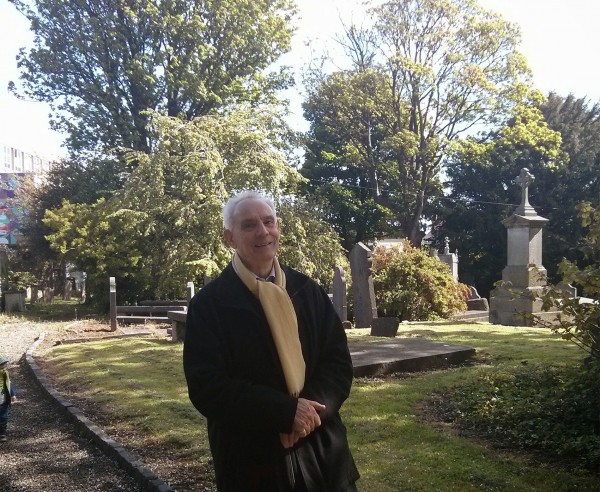
Pictured above: David Neary. Photo by Teresa Beausang.
On a bright Saturday morning in May the gates of Donnybrook Cemetery on Morehampton Road lay unlocked. NewsFour had the good fortune to discover the beauty and some of the stories of this historical treasure trove in the heart of the village.
Wearing a warm smile and a primrose scarf, David Neary greeted us. He was taking the time to sweep leaves from the paths and to try to decipher faded inscriptions in the morning light.
Neary, who is a retired Parks Department Officer and a member of the Ballsbridge, Donnybrook and Sandymount Historical Society, has been giving tours here for over seven years. He told us how he loves the trees and the light in this little graveyard. His tours, which he regards as more of a shared conversation, continue to inspire and induce him to learn more about those who rest in this sheltered spot.
The inscription by the archway reads that this site was originally that of the old Celtic church of St. Broc (Domnach Broc) whence the name Donnybrook came, and later a church dedicated to St. Mary was built here. There are 7,000 recorded burials on the grounds, many of whom would have been from prominent Dublin families in the 17th and 18th centuries.
The Graves Family Tomb is one of particular interest to Neary. Buried here is John Crosbie Graves, who was the Chief Magistrate of Dublin during the 1800s. He is the great-grandfather of poet and novelist Robert Graves, who penned the autobiographical Goodbye to All That.
Neary’s telling of the stories evokes a vivid sense of their lives, loves and losses. The two young wives of Dr. Robert James Graves were also buried here, a mere 18 months separating their deaths; in spite of the cruelty of this fate, his professional life flourished. Dr. Graves had a number of achievements; he piloted clinical medicine by introducing ‘the rounds’ system in hospitals.
He also ended the use of Latin in medical lectures, making them more accessible to students, but he is best remembered as the first doctor to recognise the full symptomatology of Graves’s Disease, a condition which causes enlargement of the thyroid gland. On hearing this, NewsFour felt a sense of gratitude to this pioneer of medicine who lifted the fog of not knowing from so many sufferers.
NewsFour’s visit was all too brief but we look forward to attending Neary’s tours, which will take place throughout the summer months.
Tour dates and times are shown on the cemetery gate a week in advance.
By Teresa Beausang



